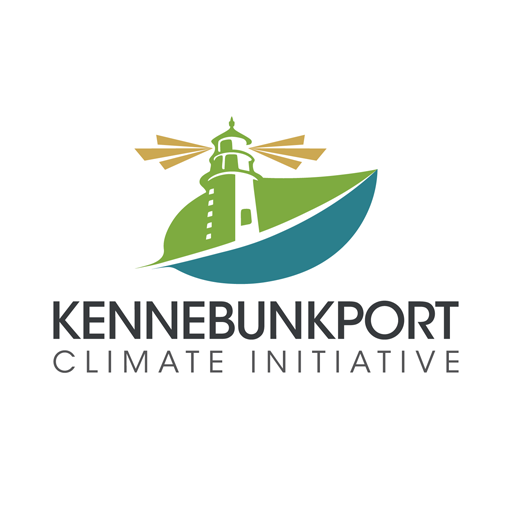Middle School | Daily Do
Why Does the Green Crab Love Climate Change?
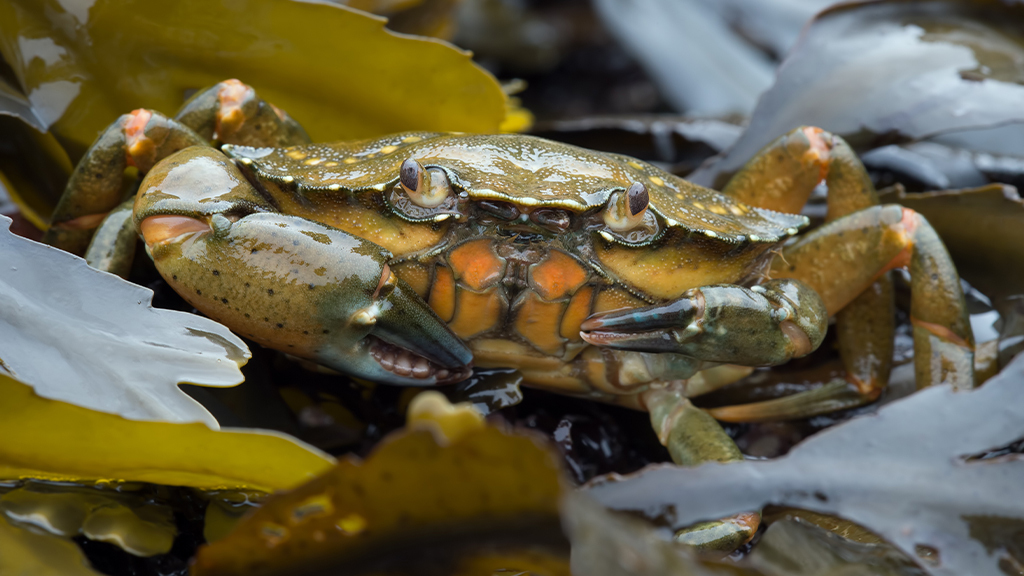
Climate Change Disciplinary Core Ideas Is Lesson Plan Life Science NGSS Phenomena Science and Engineering Practices Three-Dimensional Learning Middle School Grades 6-8
Sensemaking Checklist




Introduction
In today's Daily Do, Why does the green crab love climate change?, students engage in science and engineering practices and use patterns as a thinking tool to make sense of the phenomenon of the (dramatic) growth in the population of green crabs and their migration to new areas. While students could complete this task independently, we encourage students to work virtually with peers or in the home with family members.
View the Why does the green crab love climate change? NGSS table to see the elements of the three dimensions targeted in this lesson.
Experiencing the Phenomenon
Begin by showing students the crab "wanted poster" pictured below. Tell students you saw this poster on a trip to the east coast of the United States and then ask, “Why would a crab be wanted?” In the alone zone, have students think about what this picture might mean and record their ideas in their science notebook. Have students share their ideas as a whole group and record their ideas on the board. Ideas here will vary based on prior learning and geographic region as students that live in coastal regions might have more lived experience with these organisms. However, most students will likely come up with one of two answers: crabs are wanted because people desire to eat them, or crabs are wanted because they pinch people and need to be removed from beaches.
As students share, use talk moves to encourage others to add on to what someone is saying or share similar ideas. Talk moves could include:
-
Could you explain why you think that?
-
Does anyone have an idea that is similar?
-
What other ideas do you have about this poster?
Ask students, “Do we have enough information to determine what exactly this poster means?” Students should come to the conclusion that more information is needed.
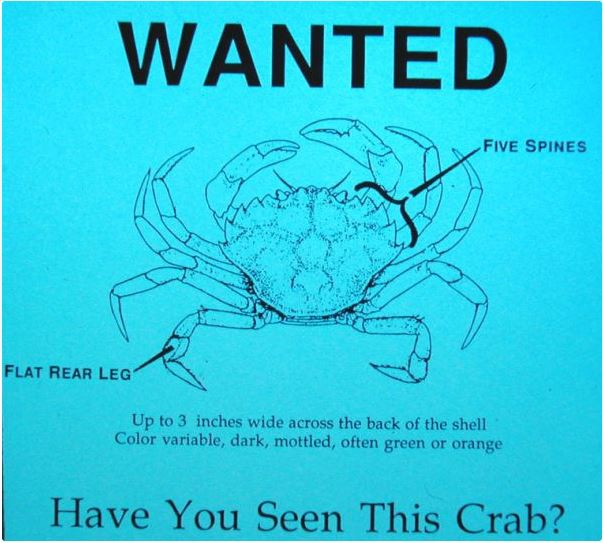
Source: Global Invasive Species Database http://www.iucngisd.org/gisd/species.php?sc=114
Next, tell students you have a short film clip to show them. Play the Our Beautiful Planet The Future of Shellfish film from 1:09 to 2:12 and have them document any questions they have about the information shared. Ask students to turn to a partner and share the questions that arose for them while watching the clip. Next have each student share a question (or a partner’s question) with the class. Common questions could include:
-
How do crabs live on the land - we thought they lived in the water?
-
Why are they collecting the crabs?
-
Are the crabs stranded up there?
-
Are the crabs climate change winners or losers?
-
Are the crabs on the beach because of climate change? Is the water too warm for them?
-
What is climate change?
-
The ocean is really big, so how does a change in temperature affect everything living in the ocean?
Make sure to ask students if they feel all of their questions are represented by the questions on the class list before moving on. Add any new questions shared.
Draw students’ attention back to the poster and ask them if they can now explain why a crab would be wanted. Students should confirm that they still don’t have enough information. Prompt students to think about what information or data they might need about the crab to figure out what the sign means. Have students brainstorm in small groups to come up with a list of things they might need to know about the green crab. Students’ lists could include:
-
Where does the green crab live (where is its natural habitat)?
-
What does it eat?
-
How did it get on the rocks or do they live on the rocks?
-
Does anything eat green crab?
-
Do people catch and eat the green crab?
Figuring Out Answers to Our Questions
To help students figure out more about the green crab, show them the Range map of European green crab below. Have students work in small groups and write down any information they can identify from the map that might help them figure out more about the green crab.
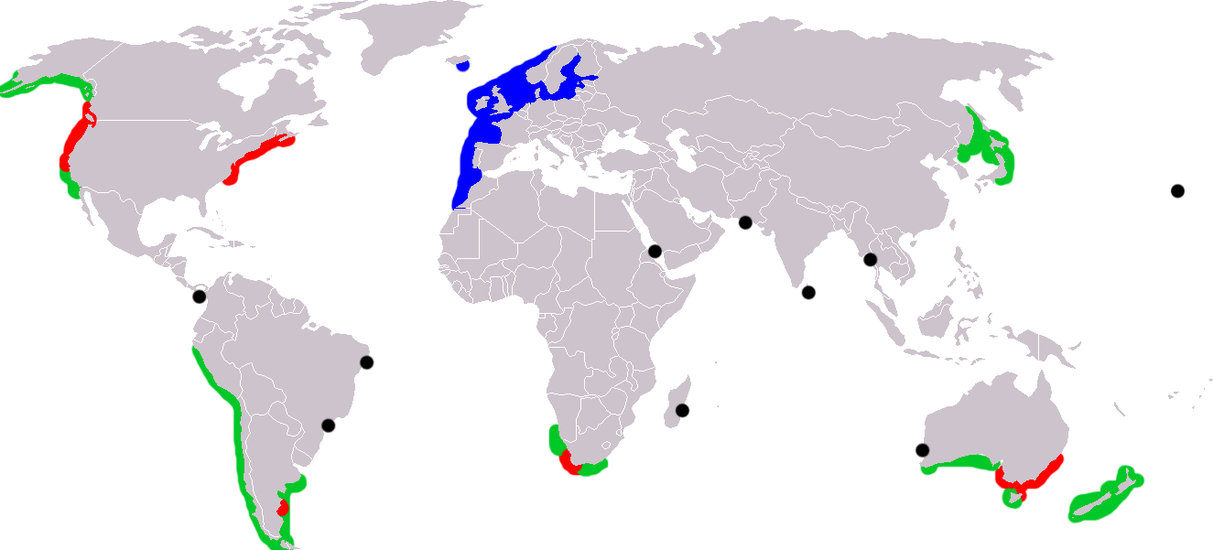
Figure caption: Rough map of the distribution of C. maenas: Blue areas are the native range, red areas are the introduced or invasive range, black dots represent single sightings that did not lead to invasion, and green areas are the potential range of the species.
Stemonitis - English-language Wikipedia ; Based on blank world map and data from CSIRO., CC BY-SA 2.5, https://commons.wikimedia.org/w/index.php?curid=1905388
Walk around the room to answer any clarifying questions students may have about the map. You can use this activity to formatively assess students’ understanding of the words native, invasive and species. If students ask about the meaning of these words, use talk moves with the small groups to surface prior learning. Talk moves include:
-
What do you think the word means based on what we have been talking about?
-
What do you remember about ecosystems in previous grades? Did you ever talk about (bees, Asian carp, butterflies)? What do you remember?
Have each group share one piece of information they pulled from the map that they think will help them figure out more about the green crab. Shared information should include:
-
The green crab is native to a small part of the world, along the west coast of Europe.
-
The green crab can now be found in five other locations - the east and west coasts of the US, southern coast of Australia, east coast of South America and west coast of Africa.
-
The green crab could spread to other parts of those countries and other parts of the world.
-
There are a few places where the green crab has been spotted but we think they don’t really live there.
-
We think where the map is red the green crabs are causing a problem and that is why they used red.
-
We think the map uses red because the green crab is an invasive species and we learned invasive species can be bad because they can eat all the food or take up all the places to live.
Have students revisit the poster from the introduction and say, “Now that we have more information about the green crab, what inferences can we make about the poster?” Give students a few minutes in their groups to gather their ideas and then have them share with the class. Most students will now think the poster is a warning and if you see the crabs you need to tell someone so they can do something to keep them out of the area/rid them from the area. Students may wonder if that is what they observed the people doing in the film clip - collecting crabs to get rid of them. Tell students you are not sure about the crabs in the clip, but agree that the posters are up as a way to help scientists and other concerned citizens keep the green crab population from spreading.
If students don’t ask why we want to keep the green crabs from spreading, prompt them by asking, “Why would we care if a small number of the green crab population is spreading?” Give students some thinking time and then have students share their ideas. Ideas will vary, but focus students’ attention on any ideas shared about how the green crab might interact with the environment. Agree that the next step is to figure out how it interacts with other organisms in the environment. Have students revisit the class list of questions to decide which one they need to answer next. Through discussion, help guide students to the questions that have to do with the crabs’ environment. Once they identify this is what they need to know next, tell students each group will be responsible for researching a different topic and reporting their findings to the class. Tell students to record important information on their groups’ whiteboards or posters.
Assign each group to research the following topics:
-
Environmental conditions: Describe the habitat of the green crab. What is the climate like where green crab populations are found?
-
Food choice: What do green crabs eat? What eats green crabs?
-
Population: How often do green crabs reproduce? How many eggs do they lay?
-
Other interactions: How do green crabs affect other living things in the ecosystem? Do they take up the space where other organisms should be living? Which organisms?
The following resources provide information about green crab habitat, food chain/web, and life cycle:
-
Downeast Institute Research - Green Crab (college-level reading but includes video support)
-
European Green Crab in Puget Sound (long article; consider assigning sections to different groups.)
-
The Quiet Invasion: A Guide to the invasive species of the Galveston Bay Area
NOTE: Many of the resources include information on all of the bulleted topics above. Depending on time and students’ ability levels, you may choose to task each group to look for information on only one topic within their assigned resource or to find information on as many of the topics as they can.
You might pair small groups together to share the information they found before they present it to the whole class; allow students to revise their whiteboard/poster presentation based on peer feedback before sharing with the class. After each group shares, ask them to place their whiteboard/poster where all students can easily access them.
These key takeaways should emerge from students’ presentations:
-
Green crabs like warmer water (64 - 79 ℉).
-
They can lay up to 185,000 eggs at a time.
-
Green crabs eat bivalves and other shellfish, eelgrass, and just about everything else they can, including each other.
-
They do not have any natural predators in the United States but some fish and some birds will eat them.
-
They are moving into new locations because the temperature of the ocean is getting warmer in these areas.
-
Green crabs are hurting the shellfish industry.
Finally, play the video Green Crabs Invading Maine Mudflats to ensure all students have the same information.
Taking Stock - What Do We Know So Far?
Students have figured out several things about the green crab and changes to the ecosystems which have occurred since the green crabs' arrival in new locations on the east and west coasts of the United States. Have students work in small groups to create a "must-have" list of components (living and nonliving)) and interactions between components that are necessary to include in a model that explains why the green crab population has grown and spread to new locations and the effect of this invasion on these environments.
Bring the students back together to create a class consensus model. You might start by inviting each group to share one component on their "must-have" list. After each share, ask the class if they agree (thumbs up) or disagree (thumbs down) the component should be included in the model. Consider asking students how components they aren't in agreement with should be represented on the model (for example, placing a question mark next to the component or drawing the component using dashed lines). Continue in this way until all components, and then interactions, have been shared and represented on the class model.
Additional Guidance: Consider using shapes (squares, circles, etc.) and arrows to represent components and interactions to add to the consensus model quickly which will allow you to keep pace with the groups' shares. An example class consensus model is shown below. The particular shapes/colors are not significant (but could be depending on how your class chooses to represent their ideas).
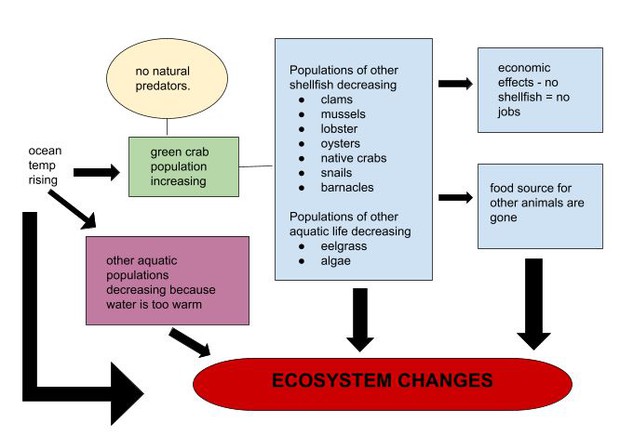
Making Connections
Now that we have put some of the pieces together, have students look at the green areas on the Range map of European green crab (above). Ask students to recall what the green areas indicate. Students should reply that those are the places where the green crab could go next. Ask students to use the class consensus model to explain why scientists are predicting the green crab will invade these locations next. If students don’t bring up the rise in ocean temperature, ask, “We know the green crabs have been in the United States for a long time (since the 1880s). Why do you think green crabs are such a problem now? What has changed?” Ask students to turn to a partner to share their thinking before asking them to share their ideas with the class. Students will likely share the green crab population has increased because the ocean temperature has increased.
Pose the question again about why scientists are predicting the green crab will move to the areas marked in green on the map. Students might share either the green crabs are moving to these locations because the water temperatures are warmer there than they used to be or they have to move to find more food (and other resources) because their population is growing. You might ask students which is the cause and which is the effect and how they could use the class consensus model to support their thinking.
Ask students if they would like to add to or revise the class consensus model before moving on to the next part of the lesson.
What Did We Figure Out? (Making Sense)
Circle back to some of the questions from the beginning of the lesson, “Why does the green crab love climate change?” and the question posed in The Future of Shellfish film clip, “Are there climate change winners and climate change losers?” Ask students to think about what they have figured out about the green crab and to develop a claim that answers the question, "Are green crabs climate change losers or winners?" Students should use the evidence they have gathered throughout the lesson to support their claim. Last, they should connect their evidence to their claim using scientific reasoning. An example is provided below:
The green crab is a climate change winner. From the articles and videos, we know that the green crab lives in warmer water, and now that the coastal waters are warmer their population has exploded. We also know that they do not have any natural predators that live in the warmer water either. This is another reason their population is increasing. Since the ocean water is continuing to get warmer, I think the warmer water will continue to spread, increasing the water temperature in other places. Since the water temperature will increase in more places this will give the green crab more places to live.
Next, ask students to think about climate change winners and losers. We have figured out the green crab is a climate change winner, but are there other winners? What organisms are climate change losers? Have students return to their small groups and use the class consensus model to support their thinking about climate change winners and losers. Then have each group share their ideas and encourage them to support their ideas with evidence from the model and/or scientific reasoning. At this point, students will probably recognize that the shellfish green crabs eat are climate change losers. Push their thinking deeper to recognize what other living things (not represented on the model) might also be “losers”. Students might offer some of the following ideas:
- Tons of green crabs on the beach might affect tourism; people and towns could lose money.
- Organisms that rely on beaches for resources might be affected.
- Warm water holds less oxygen than cold water - there might not be enough oxygen in an area to support all of the organisms who live there.
Now that students have identified some climate change losers, ask, "Do you think there are other climate change winners?" Students may predict that organisms that do well in warmer water like the green crab would also be climate change winners.
Tell students that scientists are working on figuring out if there are other winners of climate change, and may have found one. Tell them you are going to show the film The Future of Shellfish introduced at the beginning of the lesson and then play the film. Ask them to note climate change winners and losers shared in the film.
Unanswered Questions
Engage students in a whole group discussion about new noticings or wonderings about the information presented in The Future of Shellfish. Students should notice conflicting claims about how warmer water affects lobster larvae and juvenile lobsters were shared, and that both of these claims are supported by evidence. Use the evidence for conflicting claims (arguments) to lead a discussion about the nature of science; competing evidence-supported arguments often exist, especially when concepts/ideas are new. Explain that this is how science ideas get figured out and how new discoveries are made.
To wrap up the lesson, ask students if they have ideas about the lobster larvae. Have each student individually make and record their prediction about whether lobster (larvae) will end up being climate change winners or losers. Remind them to support their prediction with scientific reasoning. Ask students to share their predictions with a partner or small group; give students time to add to or revise their prediction based on peer feedback. Some students may want to share their predictions with the class. After these students have shared, suggest to the class they check on this topic periodically to see if any new evidence has been added to support or refute their predictions.
Meet Markus Frederich
Dr. Frederich is a Professor of Marine Sciences at the University of New England. He received his masters degree in biology from the Technical University of Darmstadt, Germany, where he investigated anatomical abnormalities in ants that got exposed to the Chernobyl nuclear disaster. He received his Ph.D. degree from the University of Bremen, Germany for his work at the Alfred Wegener Institute of Polar and Marine Research in Bremerhaven, Germany. Here he investigated stress physiology mechanisms in Antarctic crustaceans. For this project he also worked at the Station Biologique de Roscoff in France, and at the Instituto de la Patagonia, Universidad de Magallanes, in Punta Arenas, Chile. Dr. Frederich did his postdoctoral work at Harvard Medical School in Boston, MA, where he investigated energy metabolism of mammalian hearts using NMR spectroscopy. In 2003 he joined the faculty of the University of New England where he established his lab investigating energy metabolism and stress physiology in marine invertebrates. He also spent several summers at the Mount Desert Island Biological Laboratory, MDIBL, in Bar Harbor, Maine.
About the Our Beautiful Planet Film Series
This lesson is based on information provided in Our Beautiful Planet The Future of Shellfish. Our Beautiful Planet is a fascinating new series highlighting the work that climate scientists around the country are doing to solve some of the world’s most pressing issues. These dedicated scientists are seeking to better understand and plan for the realities of our changing climate. Using cutting edge technology and innovative problem solving, their answers are sometimes found in rather surprising and unexpected places. Our series brings the viewer along for the ride to some of the most important field work being done today, taking the science out of the classroom and into the world. These compelling stories will not only teach our viewers crucial scientific principles, but will also inspire them to use science to examine the issues their own communities face in this changing world and climate. Through these films, we hope scientists and citizens alike can come together to safeguard our environment and to protect our beautiful planet. Productions by Kikim Media. Support provided by Kennebunkport Climate Initiative.

